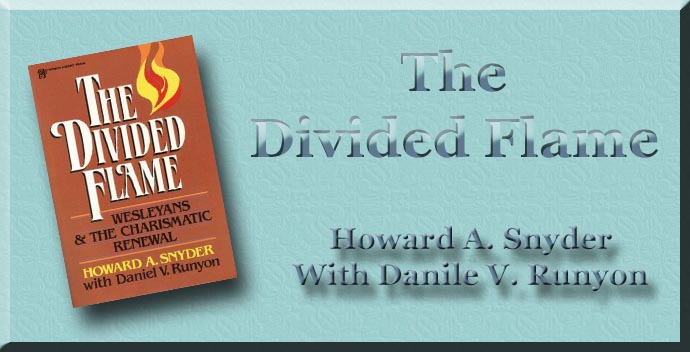
The Divided Flame
By Howard A. Snyder with Danile V. Runyon
Chapter 8
PASTORAL GUIDELINESThose who occupy responsible places in the structures of churches, schools, and denominations wonder what will happen when an outpouring of the Spirit comes. They are tempted to ask, “What will this outpouring do to our organization?” “What will our donors think?” “What will the literature the spiritual enthusiasts write do to our denominational circulations?” “What if these enthusiasts create a new church, splitting congregations into warring factions?” 1In the course of church history, many renewal movements have been condemned as heretical. However, some renewal movements have remained in the church, successfully leavening its life and witness. Examples in Catholic history include the ascetic movement of the fourth century, the Cluniac reformers in the eleventh century, the mendicant movement associated with Innocent III in the thirteenth century, and the Oxford Movement among Anglicans and Catholics in the nineteenth century. Many of the Catholic orders were renewal and reform movements in their initial stages. The most graphic examples in Protestant history are the evangelical awakenings of the eighteenth and nineteenth centuries, but many others could be cited. 2 HOW TO BE WESLEYAN AND CHARISMATICThe Roman Catholic Church has formally recognized Charismatic renewal as a positive and constructive force. Some of their efforts toward integrating the renewal movement could also be successfully adapted by Protestant churches. One Catholic approach has been to allow Charismatic prayer groups to relate to the parish in the same way as other parish organizations, with a priest or chaplain participating only at crisis moments and ceremonial events. A second technique is to appoint a bishop’s representative to the movement as is done for other lay movements. A third approach is for priests to participate actively in the renewal, both as leaders and as participants. 3 Protestant parallels to these three ideas might include:
Giving Charismatic leaders recognition and responsibility within the local church or the denomination is vital because of the community nature of the Charismatic Movement. Of course, such steps must be taken carefully and with some accountability built in. Normally a community is more comfortable choosing its own leaders rather than having a leader assigned to it by someone outside. When Charismatic leaders are not given recognition and responsibility, the usual result is conflict and division. Often this leads to the establishment of yet another church or denomination—which tends to flourish while the parent church stagnates. Charismatic leaders who break away from their mother church often do so involuntarily and reluctantly. In most cases they would rather introduce renewal to the parent church. Luther was a devout monk who longed to reform the Catholic Church, not start another. Wesley never left the Anglican Church (although often denied a pulpit) and kept the growing Methodist Movement within the Church of England during his lifetime. Another Methodist, Benjamin T. Roberts, started the Free Methodist Church only as a last resort, having been denied a voice in his own denomination, and only then at the initiative of others who had been expelled from the Methodist Church. Numerous other examples could be listed. In many cases schism could have been avoided and parent churches enriched if only those churches had welcomed with open arms the fellowship and the practice of the gifts of grace of their Charismatic brothers and sisters. We have known several churches in our own experience where this has happened, and in fact “Charismatic” and “noncharismatic” believers (in the popular sense of the term) coexist peaceably and supportively in many evangelical churches today. In failing to show this flexibility, churches have often lost the opportunity to guide renewal groups into broader maturity and usefulness. 5 CONCLUSIONIf the Charismatic and evangelical strains of the new Christian renewal movement [today] come together and unite a liberating energy with a new covenant vision for society, it is possible that a great religious awakening will take place, one potentially powerful enough to incite a second Protestant reformation.Wesleyanism already bridges the evangelical and Charismatic camps to some degree today. It has a clear message of present deliverance from inbred sin by the power of the sanctifying Spirit. If it needs anything, it is a new infusion of and openness to the power of the Holy Spirit and a new appreciation for the breadth and balance of its own heritage as seen in John Wesley himself.
|
|
 |
 |
|
1 Wayne Oates in Runyon, What the Spirit is Saying to the Churches, P. 83. 2 See Stephen B. Clark, Unordained Elders and Renewal Communities (New York: Paulist Press, 1976), pp. 2—3; and Donald Durnbaugh, The Believers Church: The History and Character of Radical Protestantism (New York: Macmillan, 1968). 3 Clark, PP. 3-4. 4 Ibid., P. 8. 5 See the discussion of the contrasting “charismatic” and “institutional” views on renewal in Howard Snyder, The Radical Wesley, pp. 125—42. 6 Jeremy Rifkin, The Emerging Order: God in the Age of Scarcity (New York: C. P. Putnam’s Sons, 1979), P. xi. |
|
-
Site Navigation
 Home
Home What's New
What's New Bible
Bible Photos
Photos Hiking
Hiking E-Books
E-Books Genealogy
Genealogy Profile
Free Plug-ins You May Need
Profile
Free Plug-ins You May Need
 Get Java
Get Java.png) Get Flash
Get Flash Get 7-Zip
Get 7-Zip Get Acrobat Reader
Get Acrobat Reader Get TheWORD
Get TheWORD